It’s been a long, long time since I’ve written anything about ecclesiastical embroidery here on Needle ‘n Thread.
Ecclesiastical embroidery is essentially church-related embroidery, and as a category of embroidery, it embraces several of the most exquisite embroidery techniques out there – especially goldwork and silk shading.
If you’re somewhat new to Needle ‘n Thread, you might not know that my real interest in embroidery sprang from art history studies in college, and specifically getting into the study of ecclesiastical embroidery when doing research for art history.
Since then, I’ve spent years collecting resources on ecclesiastical embroidery, along with old pieces of ecclesiastical embroidery. When traveling, I tend to seek out places where I can examine extant examples of historical pieces of ecclesiastical needlework. It fascinates me, and I eat the stuff up whenever I have a chance!
Lately, I’ve been pattern chasing – that is, trying the trace the origins of some ecclesiastical embroidery patterns (a very difficult thing to do!). This particular image that I’m going to share with you today has come up several times in my pattern-chasing endeavors.
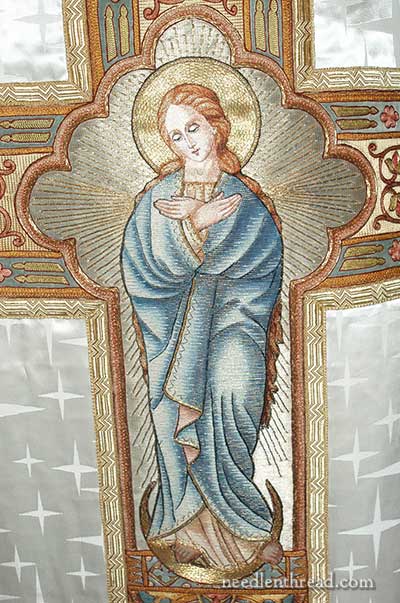
This is a hand embroidered image of the Assumption of the Blessed Virgin. The techniques in the image include silk shading (specifically on the hair more than anywhere else) and goldwork.
The embroidery is mounted on the back of a vestment called a chasuble. I’m guessing the embroidery hails from somewhere between the very late 1800’s and early 1900’s. The surrounding embroidery decorating the rest of the cross form has an Arts & Crafts Movement flavor that’s pushing towards Art Nouveau.
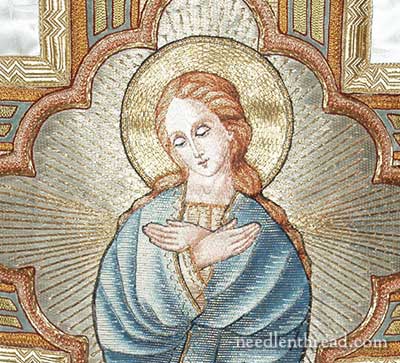
Unfortunately, when I examined the piece, I didn’t get any good macro shots, but I did take notes. At first, the face looks embroidered, and in fact, there is embroidery on it, especially where you see the shaded areas on the right side of the face and on the neck.
But this embroidery is worked over the top of a painted face. So the face was first painted, and the majority of the detail you see in it, is from the painting. The stitching is added on top of the painting to give further definition to it, but the face is not solidly embroidered. There is some delicate stitching around the eyes, nose, and mouth as well.
The hands, too, are painted first, and then stitching is added at the wrists and the back of the hand, as well as along the outlines of the fingers. The stitching on the hands and face is long and short stitch, for the most part, though defining lines are worked in stem stitch and split stitch.
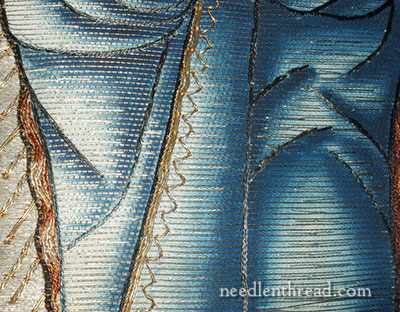
At a glance, the elaborately shaded robe might be mistaken for Or Nué. Or Nué is an embroidery technique where laid threads of gold (typically smooth passing thread, though sometimes Japanese gold is used) are stitched over with colored silk to create a picture, sometimes leaving the gold exposed (or “naked”) so that it shines through and adds to the whole impression of shading.
On the robe, you can definitely see gold lines. But if you look closely (see the lower right side of the photo), you can see that the gold lines are actually on top of the shading.
The shading on the robe is, in fact, accomplished by paint. Over the painted robe, gold lines are couched horizontally at even intervals, and between the gold lines, long straight stitches in twisted silk are worked to complement the shading.
The only solid silk shading on this piece is the hair, which is worked in split stitch in different shades of brown and tan.
The design here is very similar to the embroidered figure on these two miters that I wrote about a few years ago.
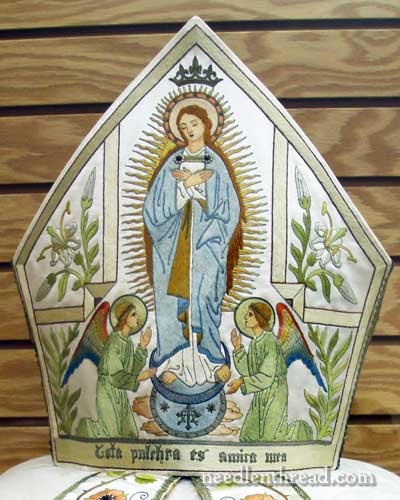
This is the first mitre, also embroidered with the image of the Assumption on it. This mitre was embroidered at a Benedictine convent in Clyde, Missouri, where it is on display in their museum. It was embroidered around the 1950’s.
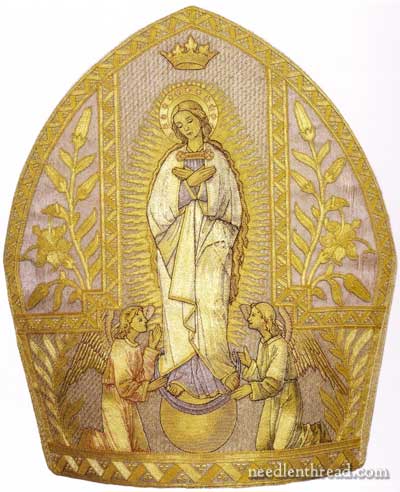
This mitre has practically the same pattern on it. It belonged to Pope Pius IX, and was embroidered sometime between 1846 and 1878.
All three pieces feature a very similarly drawn embroidered figure. This particular pose is somewhat conventional and often found in Catholic iconography. For example, in Murillo’s painting, La Inmaculada de Soult (1678), the Virgin is depicted similarly, hands folded, bare headed, standing on a sliver of the moon. So it’s not unusual to find this image on various pieces of ecclesiastical embroidery, but to find images that are so very similar (especially in the case of the two mitres) implies access to a pattern.
In any case, I’ve been chasing patterns for figure embroidery, and this is one of the designs that recurs often in my forays into ecclesiastical embroidery, where examples of figure embroidery are abundant.
When I put together this Church Patterns e-book a couple years ago, my intention was to follow up with another pattern e-book focusing on figure embroidery. I don’t know if I’ll ever get that together, but I keep collecting and researching, nonetheless!







It looks very French to me…
Mary, what lovely pieces to examine, and the subject matter – the Blessed Virgin is so appropriate on this, the feast day of her Assumption. It is uplifting to see these images on your site, many thanks.
Tomi Jane in Minnesota
Very interesting article! Keep up the research. Do you know of any groups who still do this type of embroidery?
A beautiful embroidery of a beautiful Lady on a beautiful day! Thank you, Mary, for continual inspiration. Just lovely!
Dear Mary
I hope you get around to publishing a patterned e-book on figure embroidery I would really like that. But the photos above are really lovely such detailed work even though some of it was painted it’s beautiful, I love the goldowrk on the image of the Assumption of the Blessed Virgin beautiful. Good luck in your quest for figure patterned embroidery and I look forward to the e-book. Thanks for sharing this with us.
Regards Anita Simmance
Thank you so much for sharing this information and for the history lesson too.
Lovely…Keep chasing!
Interesting choice of design, was it deliberate? Today is Assumption Day bank holiday here in Cyprus.
These are beautiful pieces featuring Our Blessed Mother! I too share your love for ecclesiastical embroidery and I love antique vestments. Have you checked out the New Liturgical Movement website. They sometimes feature antique vestments, like in this article:http://www.newliturgicalmovement.org/2010/07/praying-with-needle-and-thread-vestment.html#.Ug1Ahnbn-P8
Good luck with that pattern book!
Mary, this is a very interesting subject. Although I do not categorise myself as belonging to any particular religion, the rites and ‘trappings’ (especially of the Roman Catholic church) fascinate me simply because they are beautiful art.
Michelle, thank you for this link. I looked at all the vestments featured and oohed and aahed at the beautiful work as well as the splendid textiles the embroidery etc was on. Re the above paragraph, some of the iconography is lost on me, eg, why wouldn’t you have a red vestment with an image of Mary and the child Jesus? But these esoteric questions aside, the pieces were all simply gorgeous.
hola Mary..es un festin ver estos bordados ,,,me encanto el efecto del manto..luz sombra,textura ,,,muy bueno para mi gracias
We have a banner in our church featuring Mary and toddler Jesus and their faces and hands are painted. I hadn’t seen the painted faces before this one. It is on a cotton damask ground fabric but I think there is silk on there somewhere too. I haven’t looked at it in a few months, so my memory is getting fuzzy. Anyway, it desperately needs to be cleaned and I’m wondering how to do that without affecting the painted features. Any advice?
Mary,
I’m so glad you shared the embroidery with the painted face and hands. I have also come across an ecclesiastical figure that has painted hands and face. The detail of the painting is stunning to say the least. The eyes are penetrating. The piece can be found on my flickr account here:
http://www.flickr.com/photos/64398055@N08/8176333109/lightbox/
The interesting thing is, the piece is still in the frame and the monastery thought is was unfinished. I had a photo of the front and back, and saw stitching for the outline of the hands and face and originally thought they had been embroidered on separate ground and then attached to the embroidered garment as a technique described in an ecclesiastical book. When I next looked at and studied the piece, the painting became obvious. The painting was used on the garment to create the shading of the robe as well. It really is a lovely piece.
At the monastery, the style for this type and area of the piece is called Beuronese Art. The art form has its roots in Europe in the mid to late 1800’s. The style became well used and was mastered by many of the ecclesiastical designers at the monastery in the 1920’s through the early 1950’s. I’ve been working with some of the patterns in the archives, and the books with the figure drawings are truly stunning!
Your figure is slightly different from those depicted in the Bu
I came across your article on ecclesiastical embroidery this morning. I went the Metropolitan Museum of Art in NYC 2 days ago to see an exhibit called “Heavenly Bodies”. There are pieces (papal chasibles, capes, mitres, etc) on loan from the Vatican that date back to Pope Pius IX and earlier. They were breathtaking! Most were embroidered by the Poor Sisters of St. Clare and Sacred Heart. They were so detailed that I stood in awe for a very long time! I, too learned to embroider at a very young age so I know the work that was put into these pieces. It made me want to embroider again; this time for my Church. This is how I found your site. I am now on a mission to find patterns that I can embroider!
I just want to thank you for making that e-book. I had just become involved in a church st this later point in life and it allowed me to do something for our altar. Since then my skills and knowledge have improved and I need to try again.
Thanks
Thanks, Connie!! I’m glad to hear it has been helpful!